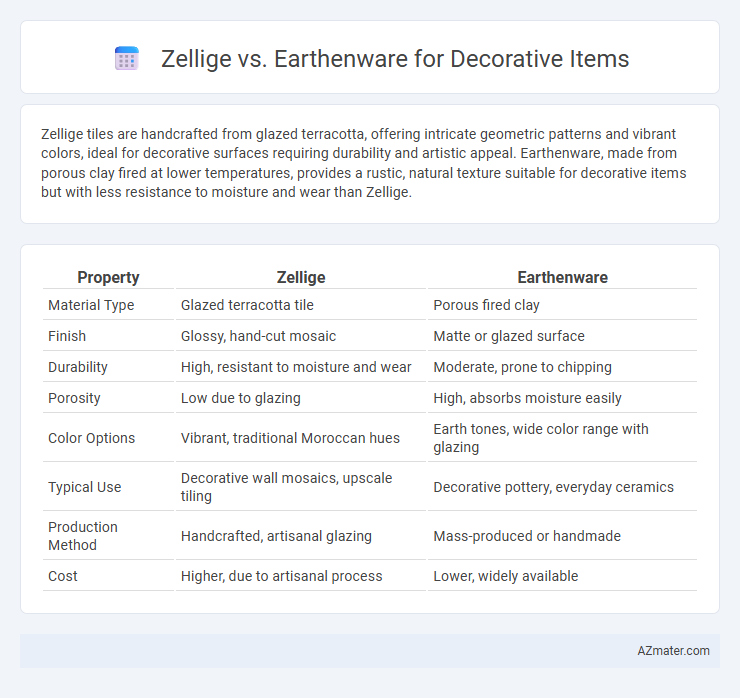Zellige tiles are handcrafted from glazed terracotta, offering intricate geometric patterns and vibrant colors, ideal for decorative surfaces requiring durability and artistic appeal. Earthenware, made from porous clay fired at lower temperatures, provides a rustic, natural texture suitable for decorative items but with less resistance to moisture and wear than Zellige.
Table of Comparison
| Property | Zellige | Earthenware |
|---|---|---|
| Material Type | Glazed terracotta tile | Porous fired clay |
| Finish | Glossy, hand-cut mosaic | Matte or glazed surface |
| Durability | High, resistant to moisture and wear | Moderate, prone to chipping |
| Porosity | Low due to glazing | High, absorbs moisture easily |
| Color Options | Vibrant, traditional Moroccan hues | Earth tones, wide color range with glazing |
| Typical Use | Decorative wall mosaics, upscale tiling | Decorative pottery, everyday ceramics |
| Production Method | Handcrafted, artisanal glazing | Mass-produced or handmade |
| Cost | Higher, due to artisanal process | Lower, widely available |
Introduction to Zellige and Earthenware
Zellige is a traditional Moroccan mosaic tile made from hand-cut terracotta pieces, known for its intricate geometric patterns and vibrant glazes that create a distinctive decorative effect. Earthenware is a type of ceramic made from natural clay fired at lower temperatures, resulting in a porous, rustic finish often used for decorative pottery and functional household items. Both materials offer unique aesthetic qualities, with Zellige emphasizing detailed craftsmanship and color, while earthenware highlights earthy textures and organic shapes.
Historical Background of Zellige Tiles
Zellige tiles originated in the 10th century in Morocco, showcasing intricate geometric patterns rooted in Islamic art traditions with influences from Andalusian craftsmanship. Unlike earthenware, which is broadly shaped from clay and fired for functional or decorative use worldwide, Zellige is specifically hand-cut from glazed terracotta, embodying centuries of artisanal techniques passed down through generations. This historical background highlights Zellige's cultural significance and its role as a symbol of Moroccan heritage, contrasting with the more utilitarian earthenware decorative items.
The Origins and Evolution of Earthenware
Earthenware, one of the oldest forms of pottery dating back to prehistoric times, originated from natural clay fired at low temperatures, making it porous and versatile for decorative items. Unlike Zellige, which is a Moroccan mosaic tile tradition with intricate geometric patterns, earthenware's evolution centers on functional and artistic ceramic pieces crafted across various cultures worldwide. Over the centuries, advancements in glazing and firing techniques have enhanced earthenware's durability and aesthetic appeal, solidifying its role in both utilitarian and decorative contexts.
Material Composition and Crafting Techniques
Zellige tiles, crafted from natural terracotta clay, undergo a meticulous hand-cutting and glazing process that results in intricate geometric patterns and vibrant colors, making them ideal for decorative wall applications. Earthenware, composed primarily of porous clay fired at lower temperatures, offers a rustic texture and is often hand-molded or wheel-thrown, suitable for both decorative and functional items. The distinct material compositions and firing methods of Zellige and earthenware fundamentally influence their durability, finish, and aesthetic appeal in decorative uses.
Aesthetic Appeal: Patterns, Colors, and Finishes
Zellige tiles showcase intricate geometric patterns with vibrant colors and a glossy, reflective finish that enhances decorative items by adding a rich, artisanal aesthetic. Earthenware offers a more rustic appeal, featuring earthy tones and matte or semi-matte finishes that emphasize natural textures and handcrafted imperfections. The choice between Zellige and earthenware depends on desired visual impact: Zellige brings elegance and complexity, while earthenware provides warmth and organic simplicity.
Durability and Longevity Comparison
Zellige tiles, crafted from glazed terracotta, offer exceptional durability due to their dense, water-resistant surface, making them ideal for long-lasting decorative items. Earthenware, being more porous and less vitrified, tends to be more susceptible to chipping and moisture damage, resulting in shorter longevity for decorative use. The enhanced hardness and glazing process of Zellige ensure superior resistance to wear and environmental factors compared to the more fragile nature of earthenware.
Maintenance and Care Requirements
Zellige tiles require regular sealing and gentle cleaning with non-abrasive, pH-neutral products to maintain their intricate glazed surfaces and prevent staining. Earthenware decorative items benefit from careful handling and periodic dusting, but their porous nature demands sealing to avoid moisture absorption and subsequent cracking. Both materials necessitate mindful upkeep to preserve their aesthetic appeal and structural integrity over time.
Eco-Friendliness and Sustainability Factors
Zellige tiles, handcrafted from natural clay and glazed with mineral-based pigments, boast exceptional eco-friendliness due to their biodegradable materials and low-energy kiln firing, making them a sustainable choice for decorative items. Earthenware, also made from natural clay but typically fired at lower temperatures, offers biodegradability yet often requires glazes containing lead or toxins, which can impact environmental safety and sustainability. Both materials present renewable resources, but Zellige's artisanal production and non-toxic finishes provide a superior sustainable profile for eco-conscious decoration.
Applications: Best Decorative Uses for Each
Zellige excels in intricate wall mosaics and luxury flooring, offering vibrant, geometric patterns ideal for accent walls, fireplaces, and fountain cladding due to its handcrafted glazed surface. Earthenware suits sculptural decor and rustic pottery, providing textured, earthy finishes perfect for plant pots, vases, and artisanal tableware that enhance bohemian or farmhouse interiors. Both materials shine in interior decoration but differ in visual impact and durability, with Zellige favored for detailed, colorful installations and Earthenware preferred for tactile, organic elements.
Choosing Between Zellige and Earthenware for Your Decor
Choosing between zellige and earthenware for your decor depends on the desired texture and cultural aesthetic. Zellige, characterized by its intricate geometric patterns and glossy glazed surfaces, offers a vibrant Moroccan flair ideal for backsplashes and accent walls. Earthenware provides a more rustic, matte finish and organic feel, perfect for pottery and decorative bowls that blend seamlessly with earthy, natural themes.

Infographic: Zellige vs Earthenware for Decorative item
 azmater.com
azmater.com